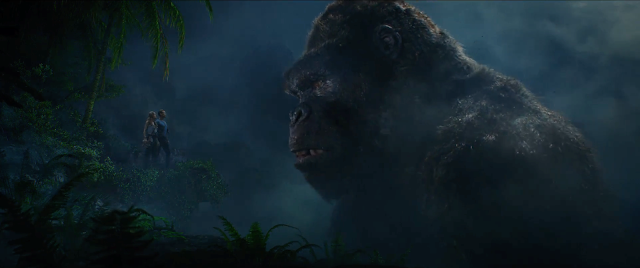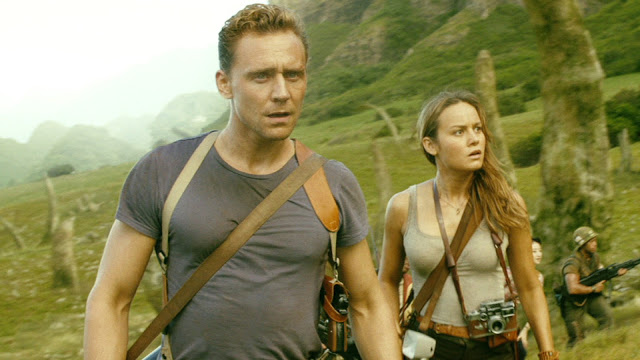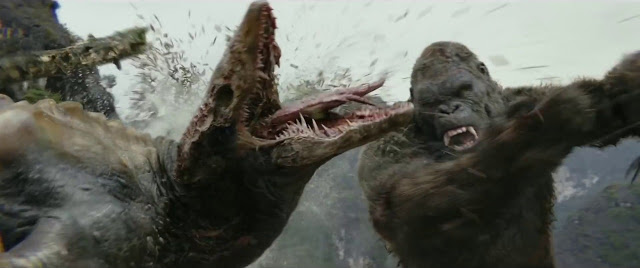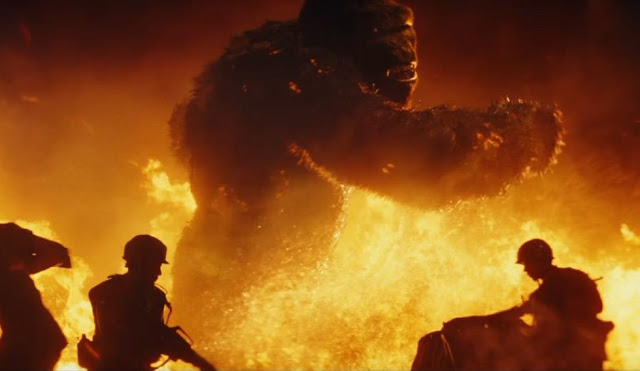One of the lasting lessons of Jaws was that shrouding your monster in mystery elevates its threat level; over the film’s first half, we grow to appreciate the terrifying power of its man-eating shark, but we don’t actually see the beast for well over an hour. Kong: Skull Island may aspire to the heights of classic ’70s cinema, but it deems this particular piece of Spielbergian wisdom to be hogwash. Here, we glimpse the titular ape almost instantly, and while he’s obscured by shadow during the prologue, by the time the first main set piece rolls around, we’re treated to the sight of King Kong in all his massive glory. He’s big, he’s mean, and you had better believe that he’s going to knock your puny little helicopter right out of the sky.
Subtle and suspenseful, this is not. But while Kong: Skull Island is undeniably blockheaded, its bluntness is also kind of disarming. Here is an unpretentious big-budget movie that is unapologetic in its prioritization of action and spectacle. If you want thoughtful storytelling or complex characters, go to the art house. Here there be monsters.
To be fair, there are also quite a few people, many played by excellent actors who were surely happy to travel the world—filming took place in Hawaii, Australia, and Southeast Asia—and to collect a paycheck. Their familiar presence also assists you in differentiating the film’s myriad characters, the vast majority of whom are otherwise indistinguishable. There are the Scientists, including Randa (John Goodman), the obsessive crackpot who’s convinced that ancient creatures roam beneath the Earth’s surface; his dogged assistants, Brooks (Corey Hawkins, currently subbing for Kiefer Sutherland on 24: Legacy) and Lin (Jing Tian, from The Great Wall); and Nieves (John Ortiz), an expert in satellite imagery whose main job appears to be looking nervous. Then there are the Soldiers, led by Colonel Packard (Samuel L. Jackson, all business), a ruthless commander with a taste for killing; his subordinates include Chapman (Toby Kebbell, jacked up and Americanized), a contemplative father who misses his son, and Cole (Shea Whigham), a laconic pilot who seems terribly unimpressed by the whole thing. Finally, there are the Attractive People, including an inveterate tracker named Conrad and an intrepid photographer called Weaver; they are played, respectively, by Tom Hiddleston and Brie Larson, the former continuing to demonstrate (in the wake of The Night Manager) that he’s well-qualified to be the next James Bond, the latter presumably showing up because she’d really like to be seen by more than the few dozen people who watched Room.
If you can remember all those names, you’re more accomplished than this movie’s screenwriters (a cadre including Dan Gilroy, Max Borenstein, and Derek Connolly, with John Gatins receiving a story credit), who treat their human characters primarily as monster fodder. Watching Kong: Skull Island is not unlike watching a dexterous and boisterous child playing with an especially elaborate set of LEGOs. The director, Jordan Vogt-Roberts (a TV vet making his second feature), maneuvers the smaller pieces with energy and skill, but their essential function is to be knocked down when the main attraction—the animal with his picture on the box—shows up and wreaks havoc.
And wreak havoc he does. The threadbare plot of Kong: Skull Island, which takes place in 1973 at the tail end of the Vietnam War, involves an expedition to the title territory, the purpose of which is to, er, use seismic explosives to help draw a map, or something. The mission’s foolhardiness is swiftly established once Kong appears, swatting the aerial vessels invading his realm, killing quite a few anonymous soldiers, and scattering our putative heroes across the island. From there, the movie proceeds as a straightforward survival story, one that is silly and pointless but also reasonably diverting. Vogt-Roberts proves adept at delivering gorilla-versus-lizard carnage, and the movie’s numerous fight scenes hum with vitality and excitement.
The same cannot be said of the film’s script, which is at best disinterested and at worst just plain dumb. The nonsensical plotting is to be expected, but the cringeworthy dialogue and false banter is less forgivable. Hiddleston and Larson’s handsome adventurers strain for a chemistry that is less flirty than awkward, while John C. Reilly later shows up as a loon who brings a necessary pinch of zaniness but whose erratic ramblings fail to produce any real laughs.
To the extent that Kong: Skull Island possesses a narrative through-line beyond “Kong kills lesser monsters and also looks sad,” it involves the bloodlust of Colonel Packard. Setting the movie in Vietnam allows Vogt-Roberts to indulge in some period hijinks; a scene of cocksure pilots flying into hostile territory of course evokes Apocalypse Now, while the soundtrack features the expected array of late-’60s pop hits. But it also adds a smidgeon of relevance to the film’s story, which could be seen as an accusatory gloss on the United States’ imperialistic impulses. Packard, still stung from the Army’s admission of defeat, comes to view Kong not as a mythical force of nature but as an enemy combatant, a military threat who must be vanquished, no matter the cost or loss of life. It’s an interesting idea, but while Jackson tamps down his fiery persona in favor of an icy rage, he cannot imbue Packard with the necessary shading to make his obsession compelling. (It doesn’t help that the script has Conrad repeatedly assess Packard’s mental state with on-the-nose lines like, “He’s lost his mind!”)
All of this would appear to cripple Kong: Skull Island, but as the movie progresses, it acquires a certain degree of dopey fun. The tropical environment helps; it generates some eye-catching imagery (there’s a sudden, startling sight of an aurora borealis), and it also distinguishes the film from its metropolitan contemporaries such as Godzilla, with whom Kong now shares a cinematic universe. (It’s oddly comforting to be able to watch a disaster picture without having to worry about all of the property damage and civilian casualties.)
Mostly, though, the pleasure derives from the diversity of the monsters and the ingenuity of the action sequences. The humans find themselves terrorized by a variety of exotic creatures—a giant arachnid with bamboo shoots for legs, a pterodactyl-like predator who plucks a hapless bystander straight off a boat, an enormous lizard with a nifty disguise and a nasty temper—each of which has been designed with admirable care and detail. Their persistent attacks could have been repetitive, but Vogt-Roberts gives each assault its own flavor and flair, as when a behemoth wades into a lake filled with napalm or when another dismissively disposes of a threat via a quick whip of its tail. In one clever scene, a swallowed Polaroid camera turns into a warning beacon, while in another, a character literally enters the belly of the beast. And in the movie’s most sublime moment, Conrad transforms from tracker to slayer, darting into a gaseous, vermin-infested fog with a sword like a star running back slicing through the opponent’s secondary.
Perhaps the most amazing and the most frustrating thing about Kong: Skull Island is Kong himself. He looks convincing (stunt double Terry Notary provides the motion-capture performance, with Planet of the Apes alum Kebbell assisting), and in a nice touch, he’s intelligent and resourceful instead of just brawny (in a scene that recalls 2001: A Space Odyssey, he strips a gigantic tree branch of leaves and uses it as a billy club). Yet while Kong is impressively rendered, he lacks the critical emotive nuance that makes him such a legend of monster lore. It was this expressive quality that made the hulking primate of Peter Jackson’s grievously underrated 2005 remake so memorable. In Skull Island, the gorilla howls and screams and smashes and beats his chest, but he never becomes a character. He may be Kong, but he’s a pretender, not a king.
Jeremy Beck is the editor-in-chief of MovieManifesto. He watches more movies and television than he probably should.




